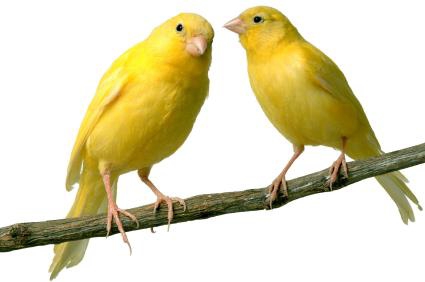Canary
Canaries originate from the Canary Islands. Varieties popular in the UK are Borders, Yorkshires, Glosters, Rollers, Norwich, Lizard and Red Factors.
Colours range from yellow, green, brown, variegated and red to various pastel shades.
Hens may twitter but cocks really sing. There is no easy way to sex canaries so seek advice from your pet shop. Changes in the environment can affect singing. The singing normally returns once settled into his new home.
If your canary goes into moult in his new home resumption of song can take six weeks or more.
Properly cared for your canary will live on average for 10 years
CHOOSING AND BUYING YOUR CANARY
A healthy canary should be:
Bright and alert
Have no signs of discharge from the eyes or nostril
Have a clean vent area
Feathers should be flush to the body and not be fluffed up
Should have no signs of breathing problems
Movement should be fluent with no signs of lethargy
HOUSING
A single caged bird will require a lot of attention and stimulus if it is not to become bored and frustrated. If the bird is to be left on its own for long periods it is better to give it a companion.
Canaries can be housed in a cage or in an aviary. A roomy cage is advisable and should be large enough for your canary to stretch his wings and fly from perch to perch.
A removable tray will make cleaning easier.
You should avoid putting the cage in draughts, direct sunlight or in damp or humid conditions. Sand sheets or cage bird sand should be placed in the bottom of the cage and replaced regularly.
The cage should be furnished with perches of different diameter and one or two toys, do not overcrowd the cage. Try and buy a selection of toys and rotate them to avoid boredom.
Remove droppings daily. The cage and furnishings should be thoroughly cleaned and disinfected with a pet-safe disinfectant weekly.
Outside aviaries must have a sheltered section to provide protection from wind, rain and strong sunlight.
This is where you should position the roosting site (the highest perch or nest box) and the food containers. Aviaries should be suitably furnished with branches of different widths.
Do not place perches directly above food and water pots.
INTRODUCING YOUR CANARY TO HIS NEW HOME
Before introducing your canary to his new home fill the food and water pots and sprinkle a little extra onto the floor to ensure that he has enough to eat until he finds his seed pots.
Make sure all windows and doors are closed and fires are guarded. Gently open one end of the carry box and let your canary walk into his new home.
If he appears anxious or does not settle, drape a cloth over three sides of the cage until he settles. This can be gradually removed as he settles. Leave him to adjust quietly.
Care should be taken not to disturb your canary at night. Night fright can cause the birds to fly into the cage wire, therefore cover the cage at night.
FEEDING AND WATER
A good quality canary mixture should be available from your pet shop.
Check the seed dishes daily and remove any empty husks. Refill as necessary. Fresh thoroughly washed green-food may be given, such as lettuce, chick-weed and dandelion and sweet apple. Be careful not to over feed though.
Cuttlefish is a source of calcium. A mineral block will provide essential minerals and trace elements. Grit helps with the digestion and should always be provided. Food and water pots should be washed regularly.
Fresh water should always be available.
GENERAL CARE
Properly cared for your canary will live a long and happy life.
- The moult (feather loss) – This is natural and usually occurs during the last few weeks of summer. At this time your canary will rarely sing and should be given a moulting tonic which helps to grow the new feathers. A soft moult at other times is usually caused by a chill or by being exposed to droughts. Again give a moulting tonic and keep warm.
- Colds – Chilling causes colds. The bird will be listless, with feathers fluffed up and wheezing. Keep him warm and do not bath. Consult with your vet.
- Diarrhoea – This is commonly caused by an excess of green food, mouldy or contaminated food, a change in diet or lack of fresh water. Keep him warm, make sure he has plenty of fresh water and consult your vet.
- Mites – Usually the red mite, this is a parasite which feeds on birds’ blood, causing itching and weight loss. Mites are easy to destroy with a suitable spray, your pet shop or vet will advise.
- Toenails – Overgrown claws need to be clipped. If left they will endanger the bird by becoming caught in the cage wire. Care must be taken when cutting nails to avoid cutting the blood vessels and nerves. Consult your vet or pet shop.

Shopping List
- Cage and cage stand
- Water pot
- Seed pot
- Perches
- Book on canary care
- Bath
- Food
- Toys
- Sand/sand sheets
- Grit
- Cuttlefish
- Mineral block
- Pet-safe disinfectant
